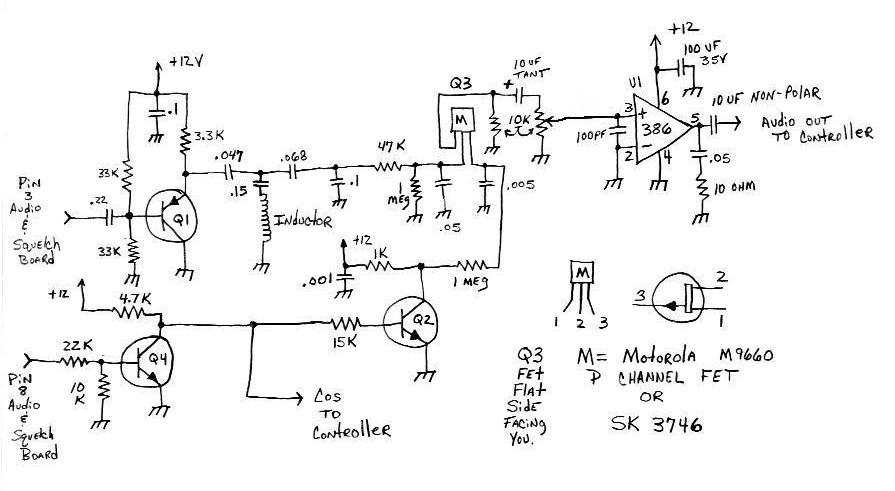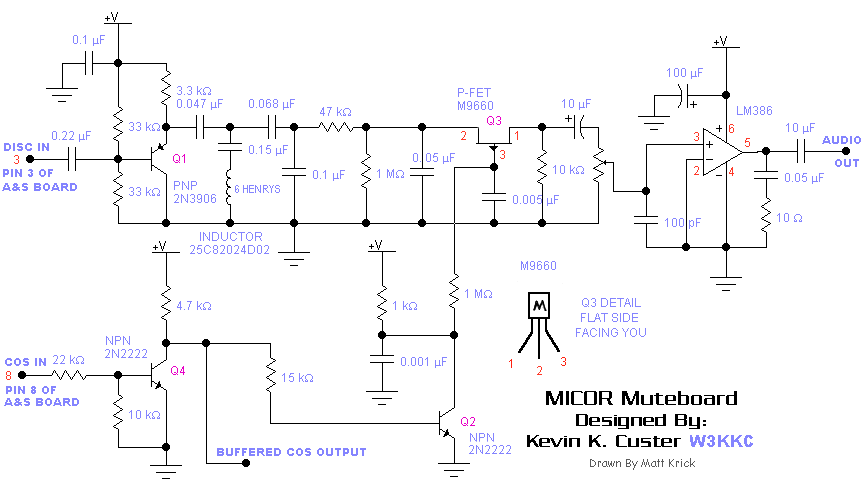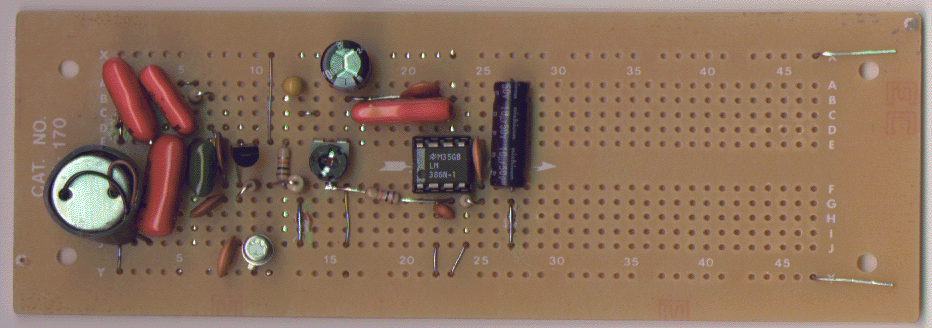Back to Home
A MICOR radio to repeater controller interface circuit
By Kevin Custer W3KKC

|
Back to the MICOR index Back to Home |
The MICOR Muteboard A MICOR radio to repeater controller interface circuit By Kevin Custer W3KKC |

|
Description: This page describes a circuit of a muting amplifier that takes discriminator audio from a Motorola MICOR mobile or Base/Repeater station and filters out the PL, buffers, deemphasizes, and squelch gates discriminator audio, and provides a low impedance driving audio source, as well as a buffered COS signal. This circuit was designed to be used to feed audio to Advanced Computer Controls repeater controllers. This circuit will work well with any controller requiring de-emphasized, squelch gated audio.
This circuit may be overkill: If you are using a newer vintage controller that accepts discriminator audio (does not require de-emphasized or squelch gated audio) go to this page: MICOR Discriminator Buffer Amplifier.
Advantages: The use of the MICOR Muteboard allows the use of the original audio path to be used to feed a local speaker. The volume control on the MICOR receiver will only control audio level to local speaker with no interaction with the repeat audio quality or level. Also, the PL filter in the Muteboard is better than the original MICOR circuitry (IMHO). If you link or remote into other repeater systems, and you use PL to access your own system, you may be transmitting your users PL into the linked or remoted system. This is not a problem unless the system you are linking or remoting into also uses PL, and you are transmitting PL on the link or remote transmitter. Here's the problem, if your user is transmitting PL and the link or remote is also transmitting PL, the two could buck if the same PL is in use, or transmitting two different PL tones can cause unacceptable results on the link or remote system. This circuit will allow the connection of any repeater controller requiring de-emphasized, squelch gated audio that has had the PL tone stripped.
Construction: The first transistor, Q1, is a Motorola M9571 or a 2N3906, Q2 & Q4 is a Motorola M9570 or a 2N2222, Q3 is a Motorola M9660 or 2N5461 FET. Caution: Only the M 9660 is represented by the transistor pinout, other transistors may be different. The inductor is a Motorola 25C82024D02 (6 Henry) salvaged from the PL board from a Motorola MOTRAC LHT or MHT UHF or Hiband Mobile radio. The Motorola part number is 4800869660 for the M 9660 if you are ordering from Motorola parts dept. Also there are two M9660's on a basestation/repeaterstation "line driver card". You can tailor the audio response by changing the value of the capacitor to ground in parallel with 1 meg resistor on the audio input side of the M9660. This value is .05 uF and can be changed in value to achieve the desired deemphasis. The value of .05 uF works well as it provides a knee at about 60 Hz, far below the point in which the PL tone is filtered (about 200 Hertz).
The "And Squelch" modification should be done to the Audio & Squelch board when using the original Motorola PL decoder board so the COS is not slaved from the PL board thus eliminating the annoying squelch tail from a user running PL and not utilizing reverse burst as in most ham equipment.
The circuit as described here has been used in my systems to drive several controllers; i.e. ACC RC-85/96/850, MCC RC-100 & RC-1000V, and several Link-Comm RLC-series controllers.
Note: If you are using a Motorola "Railroad" MICOR eliminate the circuitry associated with Q1, and Q4, feed audio into the .047 uF cap, feed COS into the 15 K resistor feeding the base of Q2, for a discriminator amplifier and COS buffer already exists.
Here's a hand-drawn schematic of the Muteboard.

Here's a computer-generated schematic of the Muteboard.

Click here to view another computer generated schematic of the Muteboard.
Here's a photo of the Muteboard, which was built on a Radio Shack breadboard by the
author. The round object at the left of the board is the salvaged 6 Henry choke from an
old receiver audio-squelch board.

Circuit design, photos and article text © Copyright 2006 by Kevin Custer W3KKC.
Back to the top of the page
Back to the MICOR index (Up one level)
Back to Home
This page originally posted on 11-Nov-2004
This web page, this web site, the information presented in and on its pages and in these modifications and conversions is © Copyrighted 1995 and (date of last update) by Kevin Custer W3KKC and multiple originating authors. All Rights Reserved, including that of paper and web publication elsewhere.